Salmon is not only a delicious seafood option but also lauded for its myriad health benefits, being an excellent source of lean protein, omega-3 fatty acids, and various essential nutrients. Preparing this delectable and nutritious fish at home is a culinary question that many ask: How long to bake salmon at 350 degrees Fahrenheit? When mastered, the result is a perfectly flaky, tender, and moist dining experience that will impress your guests and tantalize your taste buds.
In this article, we will provide you with all the necessary information and tips to make your baked salmon a success and share some mouth-watering recipes that will help transform your seafood dinner into an unforgettable gastronomic affair. So, sharpen your kitchen knives and preheat that oven to 350 as we dive into the world of salmon baking!
How Long to Bake Salmon at 350?
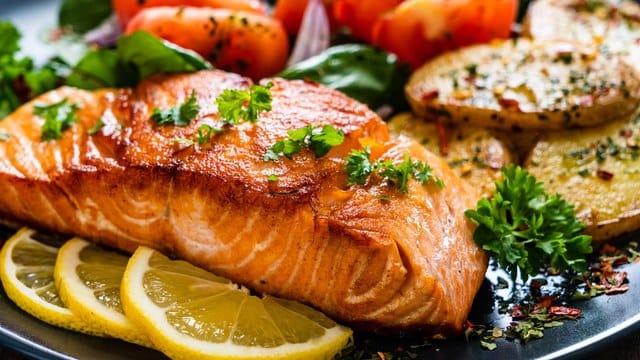
Baking salmon at 350 degrees Fahrenheit is a popular cooking method that produces juicy and tender fish. The ideal cooking time for perfectly cooked salmon in a 350 F oven is 20 to 25 minutes, depending on the thickness and preparation of the fish.
It is recommended to fold the thin outer edges of the fillets under for even cooking and to season them with salt and pepper. Salmon can also be baked in an air fryer or grilled, taking less time than baking in the oven. Monitoring the cooking process and checking the internal temperature with a thermometer to determine when the fish is cooked is essential.
How Long to Bake Salmon at 350F Per Pound
There’s no hard and fast rule when it comes to baking salmon at 350°F per Pound. However, for a 1-pound piece of salmon about 1 inch thick, it typically takes around 20 minutes to cook fully. Bear in mind that this doesn’t mean that 2 pounds of salmon will take 40 minutes and 3 pounds 60 minutes. The time it takes to bake larger pieces of salmon may vary depending on their exact size.
As a general rule, it’s advisable to use a meat thermometer to check the internal temperature of the salmon, which should be at least 145°F, according to the USDA. However, this can result in tough, dried-out fish. For a medium-rare internal temperature, the thermometer should read between 125°F and 135°F, but this carries a risk of consuming bacteria. Ultimately, the exact time and temperature will depend on the size and thickness of the salmon and personal preference.
How Long Does It Take to Bake Salmon at 350°F Without Foil?
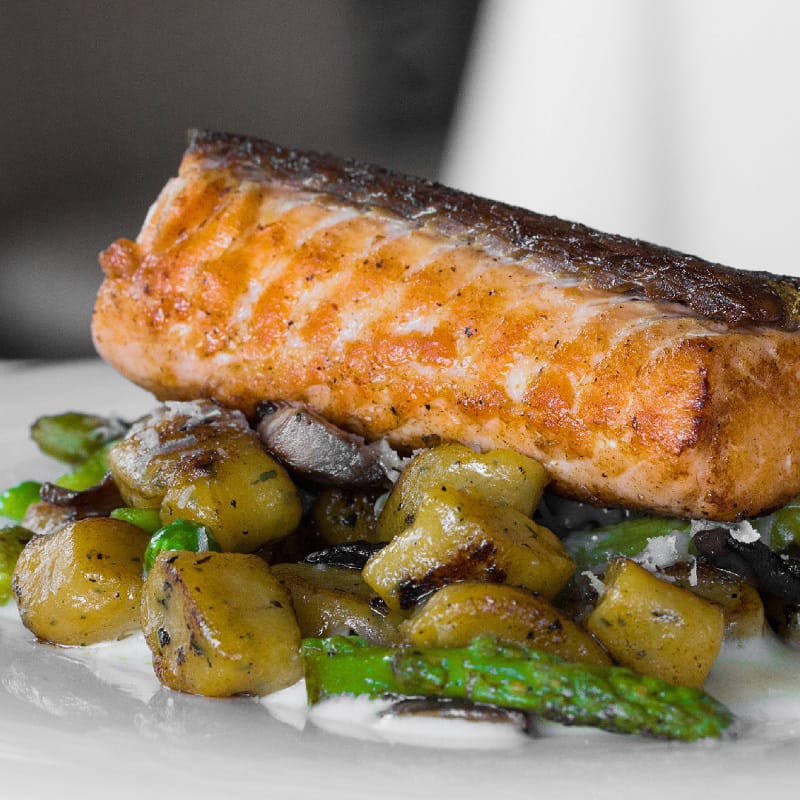
When baking salmon at 350°F without foil, the cooking time will depend on the thickness of the fish and the oven’s performance. Generally, perfectly cooked salmon should take between 20 to 25 minutes. However, if the salmon is thicker, it may require a longer baking time.
It is important to keep an eye on it and check for doneness by using a thermometer to ensure it has reached an internal temperature of 145°F. Overcooking salmon can lead to dry and unappetizing results, so monitoring it closely and avoiding leaving it in the oven for too long is essential.
How Long Does It Take to Bake Salmon at 350°F In Foil?
When baking salmon at 350°F, using foil is an option many cooks prefer as it can help keep the fish moist. But how long does it take to bake salmon at 350°F in foil?
The cooking time will depend on the size and thickness of the salmon as well as the type of foil used. Generally, it takes about 20 to 25 minutes to bake a 1-inch thick piece of salmon in foil at 350°F. However, for thicker pieces of salmon or if using heavy-duty foil, it may take closer to 30 minutes.
It’s important to check the salmon regularly with a thermometer to ensure it reaches an internal temperature of 145°F. Once it reaches this temperature, it can be safely removed from the oven and served.
How Long to Bake Salmon at 350°F in the Oven
A 1-inch thick piece of salmon will typically take about 20 to 25 minutes to bake at this temperature, depending on the thickness of the fish, whether it is stuffed or not, and the oven’s performance. However, usually, it shouldn’t take more than 30 minutes to bake salmon in a 350°F oven. It’s essential to keep checking the salmon as it cooks and use a thermometer to determine when its internal temperature cooks it through. Once perfectly cooked, the salmon should be juicy and easy to flake with a fork.
How Long to Bake Salmon at 350°F in an Air Fryer?
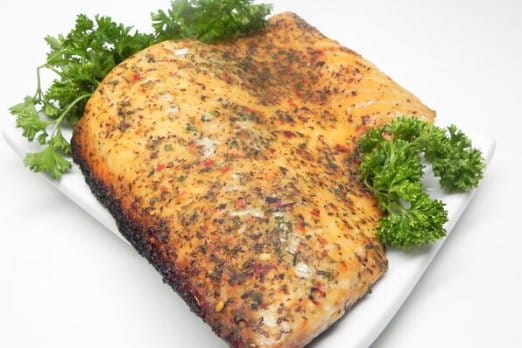
When cooking salmon in an air fryer, the typical cooking time for salmon fillets at this temperature is 12 minutes, and flipping halfway through is unnecessary. Caking thicker salmon fillets may take longer than 12 minutes to cook fully. For frozen salmon fillets, it is best to thaw them out before cooking in the air fryer, which can take under an hour.
I am adding oil or covering the salmon while air frying is unnecessary. Season the salmon beforehand with seasoning, salt, or marinade of choice. With these guidelines, cooking perfect and flavorful salmon in an air fryer at 350 degrees Fahrenheit is always achievable.
How Long to Cook Salmon at 350°F On the Grill
When grilling salmon on the grill at 350°F, the cooking time will vary depending on the thickness of the fish. For a 1-inch thick piece of salmon, it should take between 10-12 minutes to cook. The skin should be left on to become crispy and brushed with melted butter and lemon juice.
Monitoring the salmon as it cooks is essential to ensure it is cooked through, as the thickness of the salmon can affect the cooking time. It is recommended to use a thermometer to check the internal temperature of the salmon, aiming for a safe minimum internal temperature of 145°F. By following these steps, even novice grillers can confidently cook salmon on the grill at 350°F.
How to Know If Salmon Is Cooked?
As someone who loves cooking salmon, one of the most important things to know is how to tell when it’s cooked. Undercooked salmon can be dangerous, while overcooked salmon can be dry and unappetizing. So, how do you know if salmon is cooked?
Here are some tips and tricks I’ve learned over the years:
- Check the color: One of the easiest ways to tell if salmon is cooked is by its color. When salmon is raw, it has a bright pink or orange color. As it cooks, it will turn a pale pink or white color. When the salmon is fully cooked, it should have an opaque pink color.
- Use a thermometer: If you’re not confident in your ability to judge the color of the salmon, you can use a thermometer to check the internal temperature. The FDA recommends cooking salmon to an internal temperature of 145°F. Insert the thermometer into the thickest part of the salmon and wait until it reaches the recommended temperature.
- Check the texture: Cooked salmon should be firm and flaky. If you press down on the salmon with a fork, it should easily flake apart but still hold its shape. If it’s mushy or falls apart easily, it’s not fully cooked.
- Look for white protein: Another helpful tip is to look for white protein as the salmon cooks. This protein will become more visible as the salmon cooks and look like white lines on the surface. The salmon is likely fully cooked when the white protein is fully visible.
- Let it rest: Once you’ve determined that the salmon is cooked, it’s important to let it rest before serving. This allows the juices to redistribute throughout the fish, making it more flavorful and moist. Let the salmon rest for a few minutes before serving.
How to Bake Salmon at 350°F?
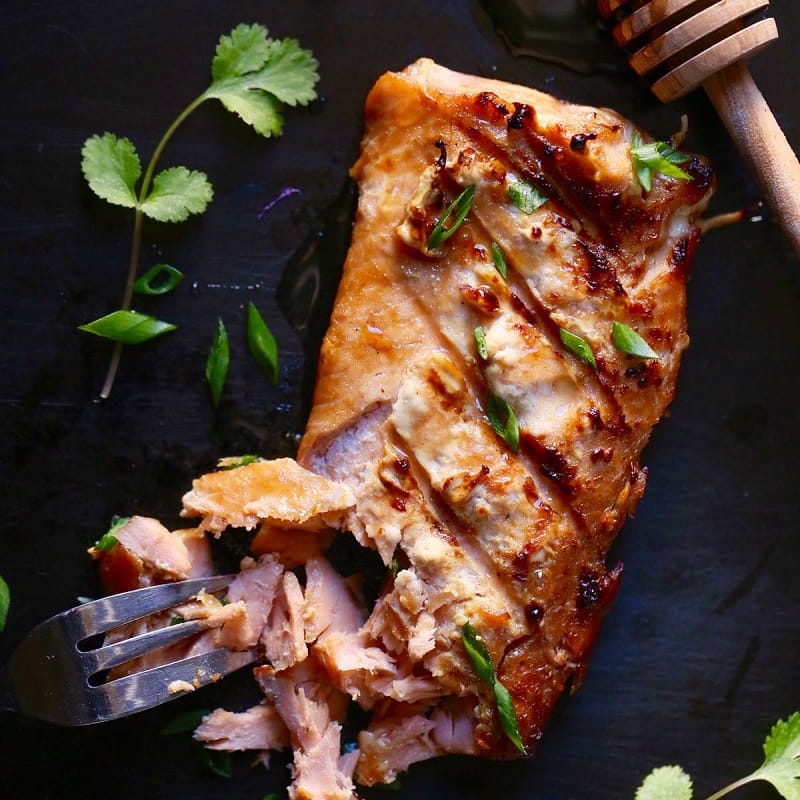
Here are the simple steps to baking salmon at 350°F:
- Prepare the salmon: Start by rinsing your salmon fillets under cold water and patting them dry with a paper towel. Then, season them with salt, pepper, and any other spices or herbs you prefer.
- Preheat the oven: Preheat your oven to 350°F. This will ensure that the salmon cooks evenly and doesn’t dry out.
- Place the salmon in a baking dish: Place the seasoned salmon fillets in a baking dish lined with parchment paper or aluminum foil. This will prevent sticking and make clean-up a breeze.
- Bake the salmon: Place the baking dish in the preheated oven and bake the salmon for 12-15 minutes. The exact cooking time will depend on the thickness of your salmon fillets, so keep an eye on them to avoid overcooking.
- Check for doneness: To check if your salmon is fully cooked, insert a fork into the thickest part of the fillet. If the flesh flakes easily and is opaque, it’s ready to eat!
- Serve and enjoy: Once your salmon is perfectly cooked, remove it from the oven and let it cool for a few minutes. Serve it with your favorite sides, and enjoy!
Read more:
- How Long Does Cooked Salmon Last In The Fridge
- How Long To Bake Salmon At 400
- How Long To Bake Salmon At 425
What to Serve With Baked Salmon?
As much as I love baked salmon, I sometimes struggle with what to serve with it. If you’re in the same boat, don’t worry – I’ve got you covered. Here are some of my favorite side dishes to serve with baked salmon.
- Roasted Vegetables: Roasted vegetables are a perfect side dish for baked salmon. Not only are they healthy, but they’re also flavorful and easy to prepare. My favorites include roasted asparagus, Brussels sprouts, and sweet potatoes. Toss your vegetables with olive oil, salt, and pepper, and roast them in the oven while your salmon bakes.
- Rice Pilaf: Rice pilaf is a classic side dish that pairs well with baked salmon. It’s easy to make and can be customized with different herbs and spices to complement the flavors of your salmon. I like to make mine with brown rice, chopped onions, garlic, and a sprinkle of parsley.
- Quinoa Salad: Quinoa salad is a great option if you’re looking for a lighter side dish. It’s packed with protein and fiber and can be dressed with various ingredients. I like to make mine with chopped cucumber, cherry tomatoes, feta cheese, and a lemon vinaigrette.
- Steamed Broccoli: If you’re short on time, steamed broccoli is a quick and easy side dish that pairs well with baked salmon. Steam your broccoli until it’s tender-crisp, and season it with some salt and pepper. You can also add a squeeze of lemon juice for some extra flavor.
- Garlic Mashed Potatoes: Garlic mashed potatoes are a great choice for a more indulgent side dish. They’re creamy and comforting, and the garlic adds a nice kick of flavor. I like making mine with Yukon gold potatoes, butter, milk, and minced garlic.
Baked salmon is a delicious and healthy dish that can be paired with various side dishes. Whether you’re in the mood for something light and refreshing or more indulgent, a side dish perfectly complements your baked salmon. So next time you’re wondering what to serve with your salmon, try one of these tasty options.
What Is The Best Way To Store Leftover Cooked Salmon?
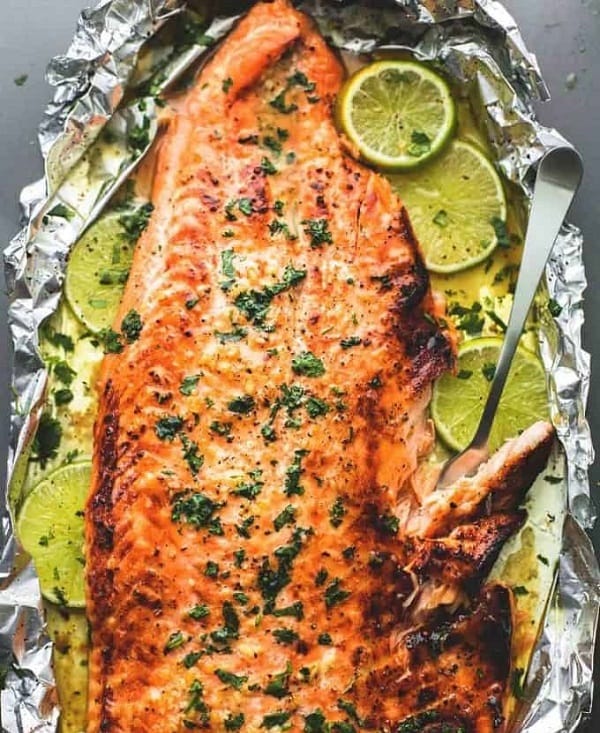
Let me tell you – the best way to store leftover cooked salmon is in an airtight container in the fridge. This may seem like common knowledge, but there are a few things to keep in mind when storing salmon to ensure that it stays fresh and delicious.
Firstly, make sure that the salmon is completely cooled before storing it. Putting warm salmon in the fridge can create condensation, leading to bacteria growth and spoilage.
Secondly, store the salmon in an airtight container. This will prevent other odors or flavors from seeping into the salmon and ruining its taste. I prefer to use glass containers with airtight lids, as they are durable and easy to clean.
Thirdly, label the container with the date that the salmon was cooked. This will help you track how long the salmon has been in the fridge and ensure you don’t consume spoiled fish.
Now, how long can you store leftover cooked salmon in the fridge? The general rule of thumb is to consume it within 3-4 days. However, if the salmon has a strong, unpleasant odor or a slimy texture, it’s best to discard it.
If you have leftover cooked salmon that you won’t be able to consume within a few days, you can also freeze it. Wrap the salmon in plastic or aluminum foil, and store it in a freezer-safe container. Frozen salmon can last up to 3 months in the freezer, but it’s important to defrost it properly before consuming it.
In conclusion, properly storing leftover cooked salmon is key to ensuring it stays fresh and delicious. Remember to cool the salmon before storing it, use an airtight container, label it with the date, and consume it within 3-4 days. And if you can’t finish it within that time frame, don’t be afraid to freeze it for later use.
Are There Any Health Benefits To Baking Salmon At 350 Degrees Versus Other Cooking Methods, Such As Grilling Or Pan-Frying?
I’ve often wondered if there are any health benefits to baking salmon at 350 degrees versus other cooking methods, such as grilling or pan-frying. After researching and experimenting in the kitchen, I share what I’ve learned.
First, let’s talk about why salmon is a healthy food choice. Salmon is an excellent source of protein and omega-3 fatty acids essential for maintaining good heart health and brain function. It’s also low in calories and saturated fat, making it a great option for those watching their weight.
Now, onto the cooking methods. Grilling and pan-frying are both popular ways to cook salmon, but they come with their own set of pros and cons. Grilling, for example, can be a great way to get that smoky flavor and crispy skin, but it can also increase the risk of carcinogens forming on the surface of the fish. On the other hand, pan-frying is a quick and easy way to cook salmon, but it can add extra oil and calories to your meal.
So, what about baking salmon at 350 degrees? Well, there are a few benefits to this method. For starters, baking is a gentle cooking process allowing the salmon to retain more moisture and nutrients. It also doesn’t require added oils or fats, making it a healthier option overall. And while some people worry that baking might result in bland or dry salmon, plenty of simple seasoning and marinade options can add flavor and moisture to the fish.
Of course, there are some downsides to baking salmon as well. It can take longer than other cooking methods and doesn’t provide the same crispy texture or smoky flavor that grilling or pan-frying can offer. But if you’re looking for a healthy, fuss-free way to cook salmon, baking at 350 degrees is worth considering.
FAQs
What Is The Ideal Temperature For Baking Salmon In The Oven?
The ideal temperature for baking salmon in the oven varies depending on personal preference and recipe guidelines. The FDA recommends cooking salmon to an internal temperature of 145 degrees Fahrenheit, which results in a firm and somewhat dry texture.
However, other sources suggest cooking salmon at lower temperatures for a more tender and moist result. For example, Cook’s Illustrated suggests cooking farmed salmon at 125 degrees Fahrenheit and wild salmon at 120 degrees Fahrenheit for a preferred texture. After trial and error, a temperature of 135 degrees Fahrenheit has been found to be the best for medium, moist, and safe-to-eat salmon.
The key to perfectly baked salmon is to remove it a few degrees before it reaches its fully cooked temperature and let it rest, allowing it to come up to temperature while retaining its moisture.
Should You Bake Salmon Skin Side Down Or Up?
When baking salmon, it is recommended to bake it skin side down. The skin acts as a protective barrier between the salmon flesh and the cooking surface, preventing it from sticking and providing a crispy texture. Additionally, baking skin-side down allows the flavorful juices to seep into the flesh, making it more tender and flavorful.
However, if the salmon is being cooked in foil, it can be cooked with the skin facing up, as the foil will protect the skin from sticking and allow the fish to absorb the flavors of the seasonings. Ultimately, whether to cook salmon skin-side down or up depends on the cooking method, but skin-side down is generally the preferred method for baking salmon.
Is it Better to Bake Salmon at 350 or 400?
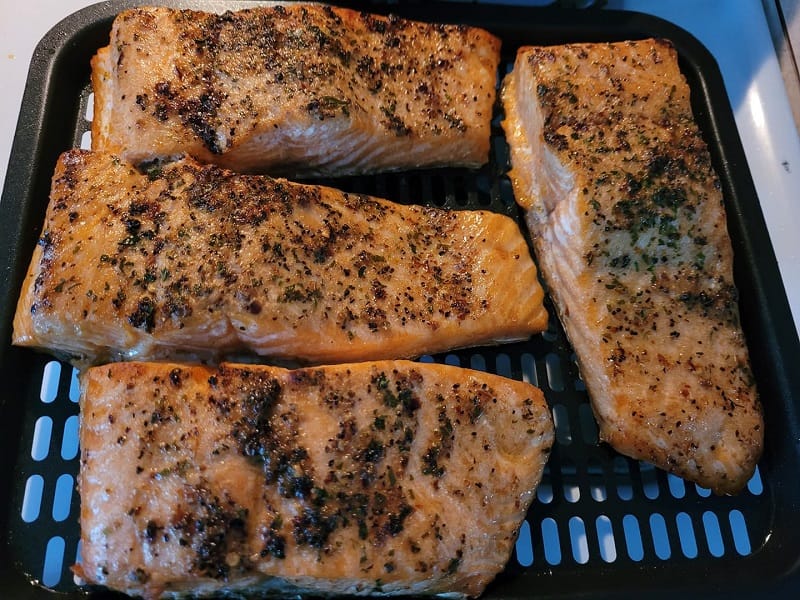
When deciding on a temperature to bake salmon, it can be tough to choose between 350 and 400 degrees Fahrenheit. However, the answer ultimately depends on a few factors. While 400 degrees is a great temperature for baking stand-alone salmon, baking it with other ingredients like vegetables is best to bake at 350 degrees. This ensures that everything on the sheet pan has enough time to cook properly.
Additionally, baking salmon at 350 degrees ensures it will cook slowly without becoming burnt or dried out. Ultimately, both temperatures can work well for baking salmon, but the decision should be made based on whether you are baking the salmon alone or with other ingredients.
Is It Necessary To Marinate Salmon Before Baking It?
Marinating salmon can significantly enhance its flavor without compromising the taste of the fish itself. Unlike red meat, fish is best marinated for no longer than an hour, or even less for more acidic marinades, making it easy to experiment with different flavors.
Marinating salmon before baking is recommended, as it can add depth to the dish and create a delicious glaze. The process involves mixing the ingredients for the marinade, coating the salmon fillets, and leaving them in the refrigerator for a couple of hours before baking. The excess marinade can then be boiled into a thick sauce to pour over the salmon once cooked. Marinating salmon is a simple yet effective way to make a delicious and flavorful dish that will satisfy your taste buds.
How Thick Should The Salmon Fillet Be When Baking At 350 Degrees In Order To Achieve An Even Cook?
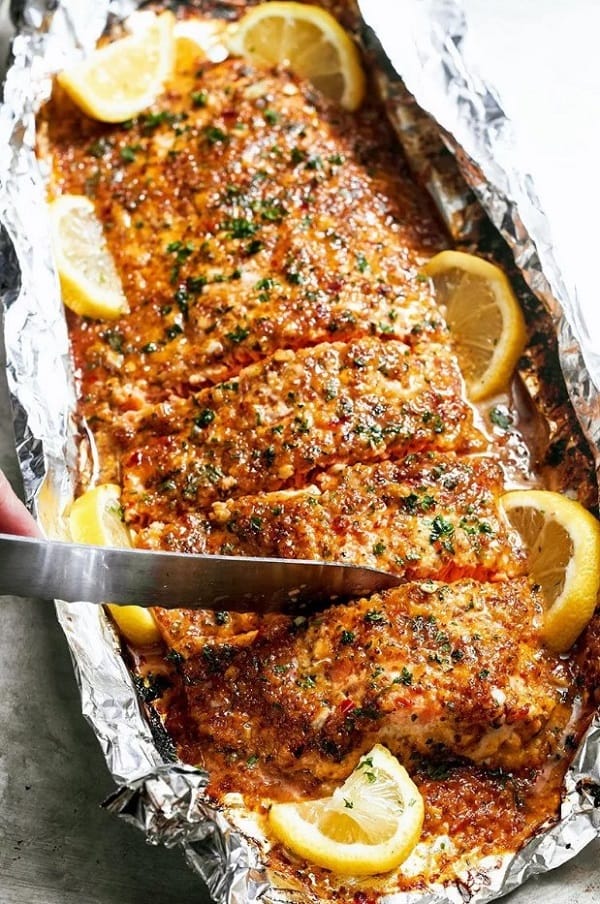
When baking salmon at 350 degrees, the thickness of the fillet is an important factor to consider to achieve an even cook. For a 1-inch thick salmon fillet, it usually takes about 20-25 minutes to cook at 350 degrees. Thicker fillets may require longer cooking times, while thinner fillets may cook more quickly.
It is best to watch the fillet as it cooks and use a fork to check for flakiness. To ensure an even cook, it is recommended to fold the thin outer edges of the fillet under even cooking and to place it on a lightly oiled baking sheet or dish. Overall, the thickness of the salmon fillet plays a crucial role in achieving perfectly cooked salmon at a temperature of 350 degrees.
Can You Use Parchment Paper Or Aluminum Foil To Bake Salmon At 350 Degrees, Or Is It Recommended To Use A Baking Sheet Directly?
While each option has its advantages, it ultimately comes down to personal preference. Parchment paper or aluminum foil can make clean-up easier and prevent sticking, but some may prefer direct contact with the baking sheet for a more crispy exterior. If using parchment paper or aluminum foil, it’s important to ensure the salmon is tightly sealed to prevent any steam from escaping and ensure even cooking.
Ultimately, whether parchment paper, aluminum foil, or a baking sheet directly comes down to individual preferences and desired cooking results.
Conclusion
In conclusion, the answer to the question “How long to bake salmon at 350 degrees Fahrenheit?” depends on the thickness of the salmon, the desired level of doneness, and the cooking method. Generally, you should bake salmon for 20-25 minutes at 350 degrees Fahrenheit. And use a food thermometer to check the internal temperature. With these tips, you can bake perfect salmon every time.

Hey readers! Chip Holland here, and I’m a Manager of this website. My passion for writing about it only matches my passion for BBQ. Follow my blog for mouth-watering recipes, tips, and tricks for the perfect smoke, grill, and BBQ. I’m sure you won’t be disappointed!
